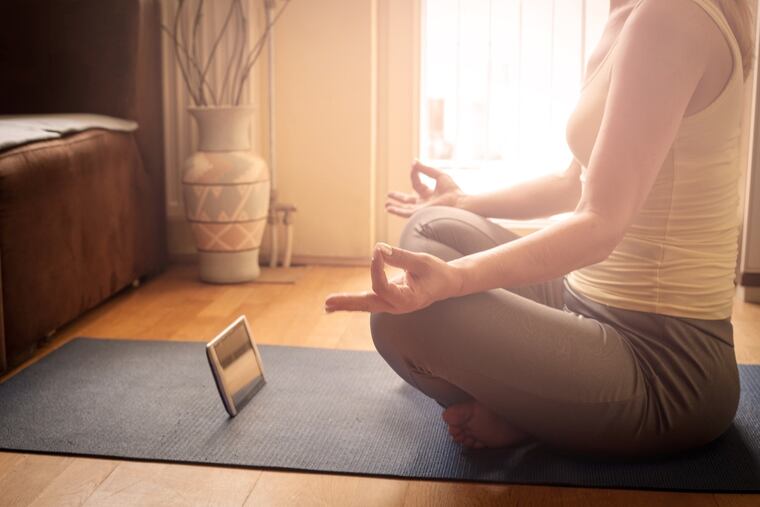Can teaching mindfulness through smartphones cure America’s loneliness problem?
A new study found teaching people awareness and acceptance — key components of mindfulness — through smartphone-based lessons decreased loneliness by 22 percent.

When it comes to the growing problem of loneliness in America, many have cited one main culprit: smartphones. They interrupt conversation. Constantly distract us. Decrease face-to-face interaction.
But a new study suggests those same phones, if used the right way, can be a great platform to teach people how to reduce loneliness and social isolation.
The study, published Monday in the Proceedings of the National Academy of Sciences, involved 153 adults practicing 20-minute guided meditations on their phone each day for two weeks. By the end of the study, those whose meditations focused on developing acceptance and awareness — key components of mindfulness — felt 22 percent less lonely and had two more social interactions per day.
“Acceptance is the key piece,” said Emily Lindsay, a coauthor of the study and a postdoctoral fellow at the University of Pittsburgh. Learning to experience feelings without being too critical or pushing them away can help people cope with loneliness.
And being able to focus on the present moment — the core of mindfulness practice — can improve your social interactions, said Michael Baime, director of the Penn Program for Mindfulness, who was not involved in the study.
“Because the people in your life are a really important part of what you pay attention to, it has a huge impact on how others experience you and how you experience others,” Baime said.
What’s surprising, though, is that a technique that has been passed down from teacher to student for thousands of years can be effective through a phone.
“It flies in the face of conventional wisdom and historical precedents that you can do it with a device in your pocket,” Baime said.
In the study, participants were randomly assigned to one of three groups.
The first practiced meditations based on awareness. They focused on physical sensations, like the process of breathing and the feel of clothes on their skin.
The second group practiced awareness and acceptance. In addition to recognizing the sensations in their body, they were also told to welcome them, saying “yes” in a gentle tone anytime they noticed something new. A pleasant breeze? Yes. Back pain? Yes.
“Regardless of it being good or bad, pleasant or unpleasant, they learned to accept it,” Lindsay said.
The final group served as a control, focusing on free reflection and problem-solving skills without any mindfulness content.
For three days before and after the intervention, participants answered questions on their phones five times a day, noting their stress levels, feelings of loneliness, and number of social interactions.
Individuals in the awareness and acceptance group were the only ones who saw a meaningful change in loneliness.
The researchers found a similar pattern with stress, which is often the reason people turn to mindfulness meditation. Only those in the awareness and acceptance group showed significant decreases in physiological markers of stress.
Because the follow-up was limited to a few days, though, authors can’t say how long the results would last. They also don’t know if it would be just as successful with meditation apps now on the market, since the study used a specially designed intervention.
The finding could be a step toward mitigating a nationwide problem of loneliness. A 2018 study of 20,000 Americans by health insurer Cigna found nearly half sometimes or always feel lonely, and only 53 percent have meaningful in-person interactions, like talking to a friend or spending time with family, on a daily basis.
Research has shown loneliness is one of the strongest predictors of poor health and early death, yet medical professionals are struggling to find ways to alleviate it.
“It’s a serious deficit we’re all feeling,” Baime said. “But we don’t address it because we don’t have a good way to intervene.”
While one study is not enough to prove smartphone-led meditation is the solution, it’s a promising start, he said.
Moving forward, researchers hope to better understand exactly how mindfulness decreases loneliness.
One possibility is that it helps individuals reframe the emotion in a new way, Lindsay said.
“There’s a distress associated with loneliness,” she said. “It’s uncomfortable.” That’s why people often turn to TV or work to avoid it.
“But if you practice staying with that feeling, monitoring it and accepting it without judgment, without ruminating on what it means for your future,” Lindsay said, “that can change.” It can become a feeling of peaceful solitude.
Mindfulness may also reduce loneliness by improving the quality of interactions people have with others, Baime said.
“Mindfulness teaches you to show up here,” he said. “And when you show up, you find there are other people here too.”
Rather than speaking to the cashier at a store with the automatic, “Fine, thanks, how are you,” you might actually look at them. Or instead of coming home and just asking what’s for dinner, you may sit down with your partner for a focused conversation about their day.
It sounds so simple, Baime said, but research has shown that practicing mindfulness over time can actually change the structure of the brain. Scans have shown that the amygdala, which is thought to be where emotions like panic and rage originate, is reined in after eight weeks of mindfulness practice, while neural systems that control attention and emotion regulation become stronger.
“The world isn’t any different,” Baime said. “But mindfulness changes the way we experience the world.”